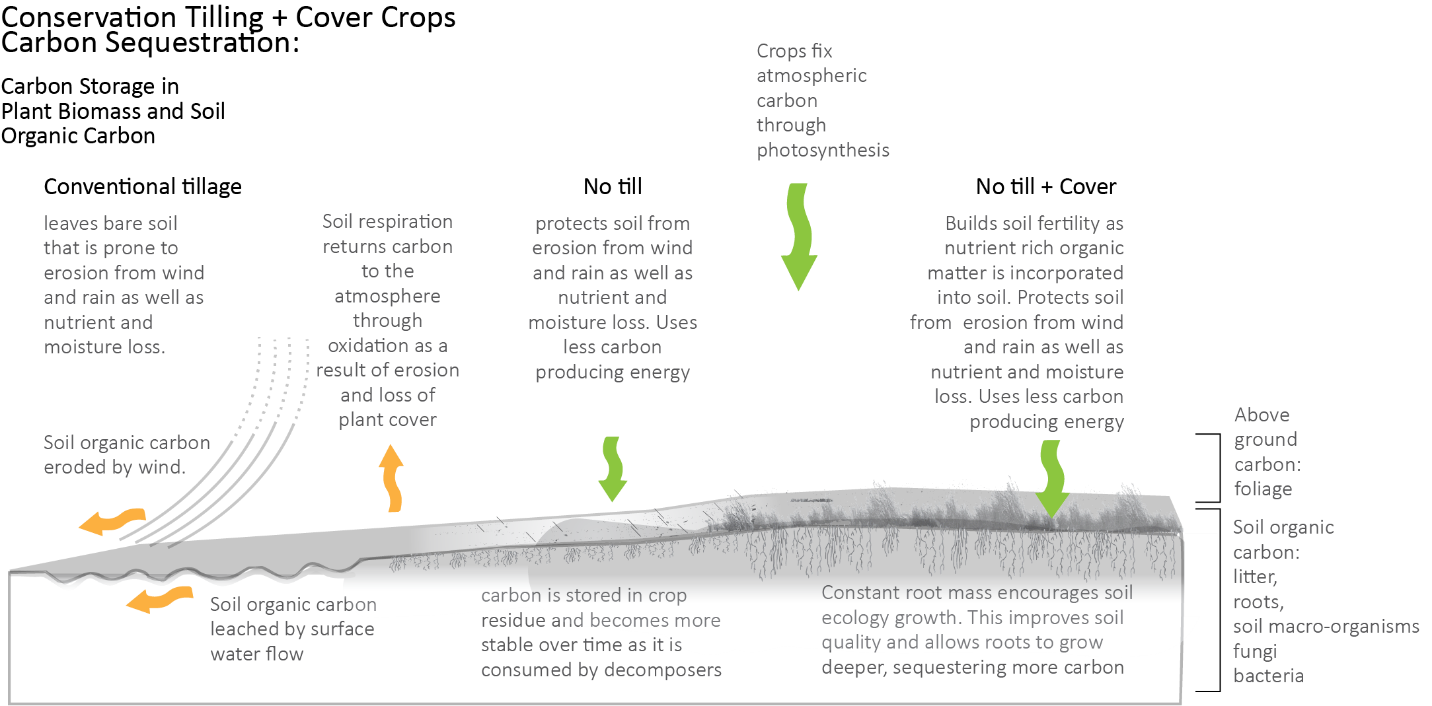Conservation Tillage
Minnesota farmers are using conservation tillage more frequently than in the past, particularly in corn and soybean rotations. Soil erosion control, water quality improvement, increased nutrient retention, and lower production costs are among the many environmental and economic benefits associated with conservation tillage practices.
No-till and other conservation tillage practices have proven successful in controlling soil erosion and providing other benefits. Conservation tillage practices have the additional benefit of sequestering more carbon than conventional agricultural tilling practices. There is a range of beneficial tilling practices; the most beneficial are those that disturb soils the least, including no-till and strip till.1,4
Soil microbial biomass has become an indicator of soil quality and increased nutrient retention and soil structure. Additionally, studies have found that beneficial micro-organisms including bacteria and fungi are especially effective in storing carbon, and they are negatively affected by tillage.2,3,4
But conservation tillage practices alone are not the solution to greater carbon sequestration in agricultural systems. Combining conservation tillage with cover crops has been proven to significantly increase soil organic carbon in addition to benefits that include increased infiltration, nutrient retention and decreased erosion potential.2,4 No till and cover crop practices together provide greater benefits than either practice does individually.4
Issues of carbon sequestration notwithstanding, BWSR encourages the use of conservation tillage and cover crops to protect soil quality, reduce soil erosion and improve water quality in local waterways.
Cover Crops Store Carbon
Cover crops are grasses, legumes and forbs planted to provide seasonal soil cover when the soil would otherwise be bare - before the main crop emerges in the spring or after fall harvest. Cover crops sequester carbon by adding biomass both on the soil surface and below-ground. Research suggests that the majority of soil organic carbon originates from root biomass. Underground carbon persists longer than above ground depositions. Cover crops encourage beneficial root-zone fungi, bacteria and invertebrates who also contribute to soil carbon and protect it over time by forming aggregates which increase overall soil health and productivity. 4
A 12-year University of Illinois study showed that adding cover crops to all tillage treatments increased soil organic carbon stock gains by 30% for no-till, 10% for chisel plowed and 18% for moldboard-plowed plots.6
Planting in late summer allows cover crops to generate substantial biomass throughout the fall and again in the spring. Winter rye is a good choice because it is more resistant to decay than other cover crops such as oats or barley.
1. Reicosky, D. C. Conservation tillage is not conservation agriculture. Journal of Soil and Water Conservation 70, 103A-108A (2015).
2. Soil Health Practices and No-till Farming Transform Landscapes | NRCS. Available at: https://www.nrcs.usda.gov/wps/portal/nrcs/detail/national/newsroom/features/?cid=nrcseprd1307111. (Accessed: 21st June 2019)
3. Zuber, S. M. & Villamil, M. B. Meta-analysis approach to assess effect of tillage on microbial biomass and enzyme activities. Soil Biology and Biochemistry 97, 176–187 (2016).
4. Mbuthia, L. W. et al. Long term tillage, cover crop, and fertilization effects on microbial community structure, activity: Implications for soil quality. Soil Biology and Biochemistry 89, 24–34 (2015).
5 .Nivelle, E. et al. Functional response of soil microbial communities to tillage, cover crops and nitrogen fertilization. Applied Soil Ecology 108, 147–155 (2016).
6. Olson, K, S.A. Ebelhar and J.M. Lang. 2014. Open Journal of Soil Science 4: 284-292.

